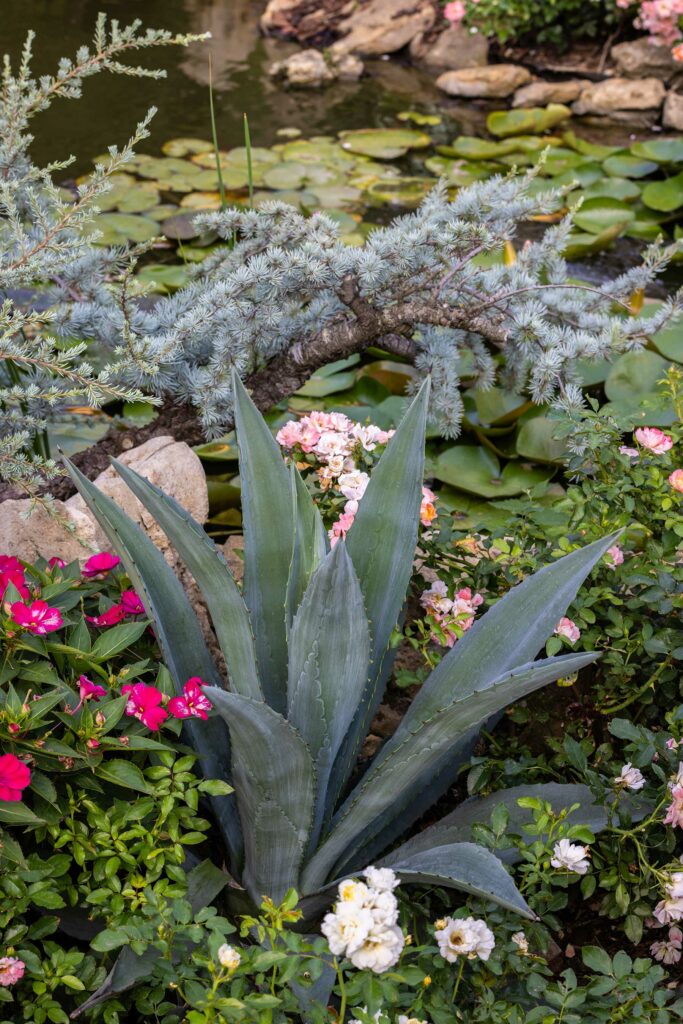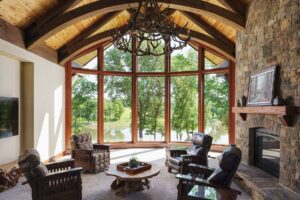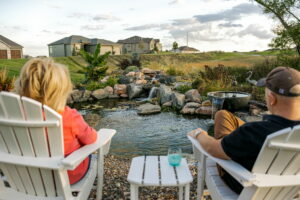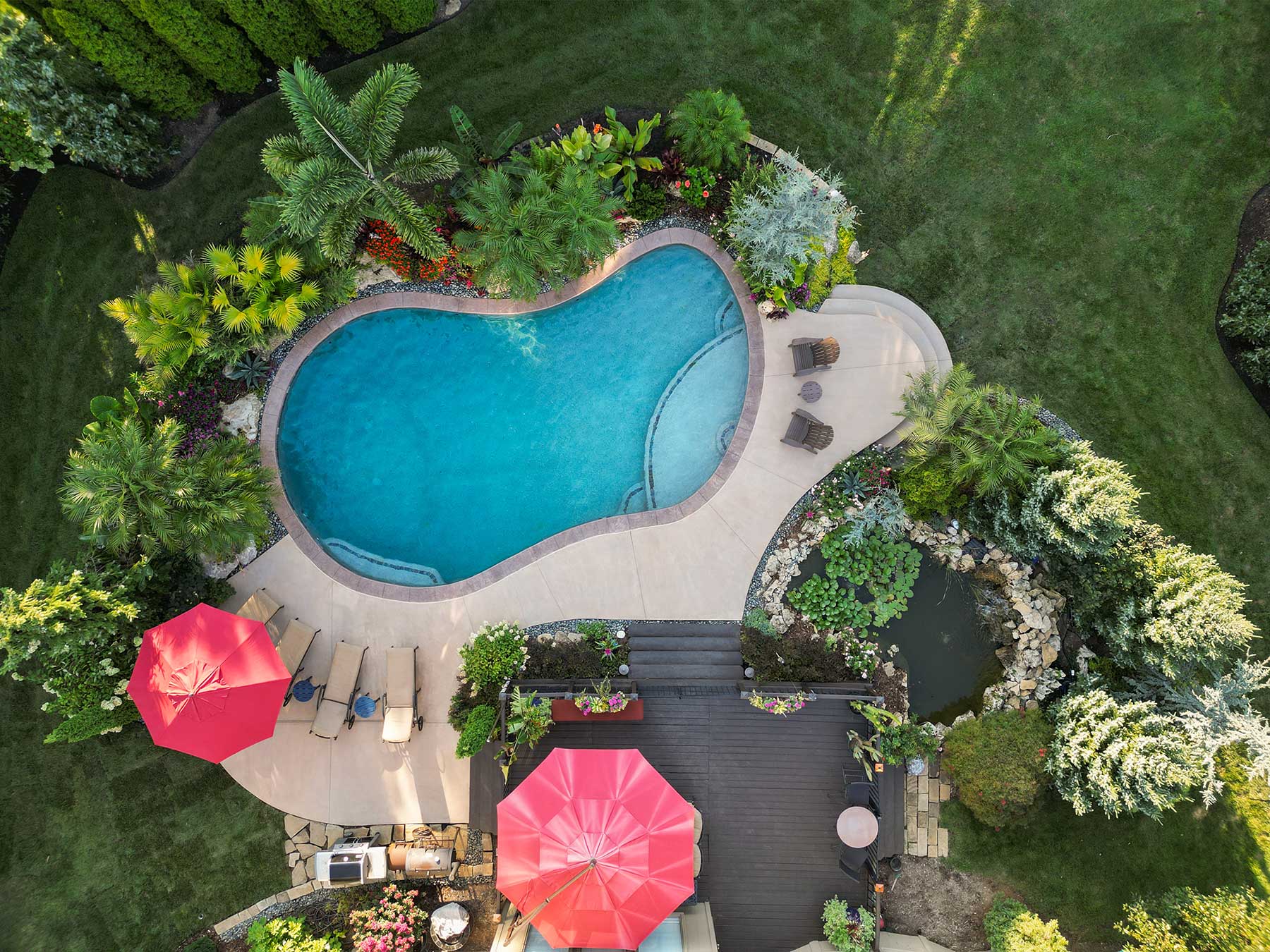Canna and Banana
Words by Andrea Darr | Photos by Josie Henderson
Tropical plants travel north for the summer for a spectacular season in the Midwest.
icardo Medellin didn’t plant an entire three-sided green screen and tropical bermed “island” around his Overland Park property because he didn’t like his neighbors; he did it because he wanted an oasis, a place to slow down and meditate, to watch the plants and the grandkids grow up.
A memory of a Key West courtyard where he once sipped coffee hung in his mind like the jungle of vines on that trip, the wild nature of it enveloping his senses. Inspiration struck a chord in the heart of this Kansas landscaper that day and opened his perspective on what he could plant far away from a temperate climate.
Tropical plants are nothing new to Kansas. Gardeners have always potted palms and erected elephant ears along their patios and front doors. But Ricardo wanted an entire environment, and he thought his clients might want that, too.
He opened an office in Florida and became a plant broker, tagging the best species directly at the growers. He shipped his first batch to Kansas in 2022. “It went well—gangbusters, actually,” he says.
His clients have long trusted him to find the balance between an efficient landscape and one that doesn’t have enough. A lot of that is done on the fly—a mix of intuition and experience. Not so much in his commercial business, where a plan is necessary, but in residential work, “the process can be more interesting, if allowed,” he says.
Tropicals can bring a sense of wonder and the unexpected, especially around these parts, where their foreignness captivates our attention. Native plants can get leggy, turn brown at the tips with overwatering or underwatering, or wither under too much sun or a sudden shift to cold, but tropicals are often sturdy stalwarts. They can withstand the powerful force of hurricanes or thirst from drought and still not only survive but thrive.
Ricardo’s epiphany was almost a happy accident, one might say. “We are freakin’ Bob Ross,” Ricardo says with a smile, referring to the way his company wields plants in the way Bob paints. Except Ricardo’s artistic tool is a shovel.
At his own home, Ricardo evokes a feeling of tranquility, starting with that green screen of 70 trees on the outskirts of his ¼-acre property. It only hints at formality—not so much a rigid, “keep-out” kind of hedge, but rather a zig-zagging repetition of evergreens (‘Bruns’ Serbian spruce, ‘Riverside’ Serbian spruce, Emerald Green arborvitae) and shrubs—some familiar and flowering, like hydrangeas, and others very trendy, like the spindly Dr. Seussian Blue Atlas cedar.
A lush lawn separates the traditional from the tropical, where a three-foot rise in elevation then transitions to a more intimate invitation around the pool. Here, Ricardo mixes native perennials with punches of color and tangles of texture from elsewhere.
Palms make an incredible focal point, their smooth-barked trunks rising up overhead, splaying out frilly fingers that sway in a breeze. A foxtail palm near the center of the berm is a stunner. Clients love when Ricardo leaves the trunk uncut in the landscape over winter—it looks cool in the snow.
Ricardo’s daughter, Natalie, a plant specialist, helps him with selections and care, which is surprisingly not a lot when it comes to tropicals. Water them, of course, but fertilize them? Not so much. Ricardo’s trick is to plant them close together—they’ll compete with each other for growth.
Watering can be a tricky task; the amount to use is dependent on the time of year.
“You have to manage it,” Ricardo says. “And it’s the flowers that need the most water, like annuals. Annuals are more water hogs than any tropical. Once a palm hits the dirt, it takes off.”
At the end of the season, in an attempt to salvage temperature-sensitive plants, some gardeners will dig up roots and bulbs to overwinter inside. Natalie does not recommend that.
“It’s stressful to the plant,” she says. “You’ll spend your time and money caring for it, just to keep it alive, and it will never look as good again.”
So, best to start fresh each season, and the time to order is now. Then you can sit outside with vacation vibes, admiring nature’s strength and abundance—and like Ricardo does, sigh and think, “Wow, this is what it’s all about.”
Landscaper: Medellin Landscaping & Gardening, medellinlandscaping.com

You may also like these articles.

Your dream home starts with Pella windows and doors
Replacing old or inefficient windows and doors is a great way to increase energy efficiency, as well as modernizing your home’s look and style.

French Bistro at Home
Delicious curves, dramatic contrasts and gleaming golds accentuate a renovation project in Kearney that’s dually functional and opulent.


Walls of Renaissance
Wallcovering trends showcase bespoke styles, vibrant hues and textured expressions.

The essence of a water garden: You don’t know what your outdoor living space is missing
Good Earth Water Gardens creates intimate outdoor living spaces that are designed around water.

A Lit Collection
Moody lighting and deep, dark tones set the stage for a bourbon bar and a music room.





Leave a Reply